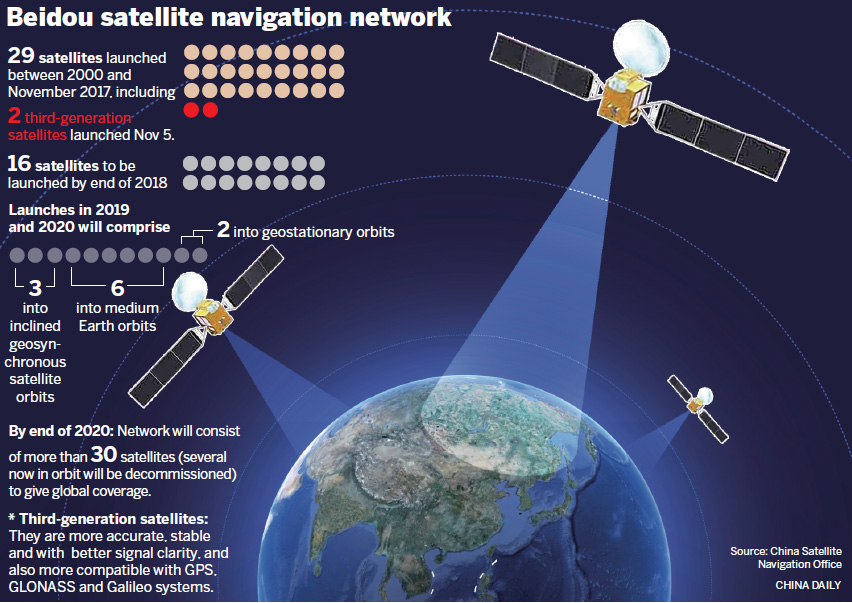
Apr 21, 2024
The Rise of BeiDou Satellite Network: China's challenge against GPS
BeiDou is a global radio navigation system operated by China's National Space Administration. This system bears many similarities to Russia's GLONASS, Europe's Galileo, and America's GPS. BeiDou is one of many significant projects that grant China independent capabilities in the realm of space.
BeiDou's evolution can be traced all the way back to the early 2000s with BeiDou-1 coming online, providing navigation services for China. This network then laid the groundwork for BeiDou-2, and subsequently, BeiDou-3. The current BeiDou network finished construction in 2020 and provides higher accuracy in the Asia-Pacific region than the GPS network. BeiDou has also been an integral part of China's national infrastructure plans while aiding State-Owned Enterprises (SOEs) like CASC and CALT. China also has plans to expand the BeiDou network and integrate it with their future lunar communications network.
The history behind BeiDou is even more interesting than the system itself. For decades, the United States was the leading power in global satellite navigation technology. The GPS was originally designed for military use but has become indispensable to the lives of its citizens and even other countries. A global satellite navigation system aids transportation, construction, agriculture, tracking, military operations, communication, and more. Reports show that if the United States GPS were taken offline, it would cost 1 trillion dollars a day in losses. Similar integration has been becoming more and more clear with the BeiDou network in China.

In 2020, China finished its own satellite navigation system and started intensely challenging GPS dominance in space. The network first hyper-focused on China and then became a system of global coverage. Shortly after, the integration of BeiDou into China's economy was substantial. All of this was accomplished in the span of 20 years, showcasing the true strength of Chinese capability. BeiDou-1, which began construction in 2000, was a very small rudimentary network only offering services to China and had very few commercial applications. Now, China's BeiDou constellation is a strong and robust system offering many benefits to China. What we can see in China's expansion in only 20 years goes well beyond the eye-catching Shenzhou crewed missions; it is a clear representation of rapid development. China's BeiDou started in 2000, with the first taikonaut in 2003, the first lunar orbiter launched in 2007, and now they have a fully-fledged navigation system, operational long-term space station, and have operated two rovers on the moon, one of which in a previously unexplored region, and received lunar samples. BeiDou is an often-overlooked example of how China quickly develops.
The history behind BeiDou is even more interesting then the system itself. For decades, the United States was the leading power in global satellite navigation technology. The GPS was originally designed as a military school but has become indispensable to the lives of its citizens and even other countries. A global satellite navigation system helps transportation, construction, agriculture, tracking, military operations, communication, tracking and more. Reports show that if the United States GPS was taken offline it would cost 1 trillion dollars a day in losses, similar integration has been becoming more and more clear with the BeiDou network in China. In 2020, China finished its own satellite navigation system and started intensely challenging GPS dominance in space. The network first hyperfocused on China and then became a system of global coverage, quickly after that the integration of BeiDou into China's economy was huge. This was all accomplished in the span of 20 years, showcasing the true strength of Chinese capability. BeiDou-1 which began construction in 2000 was a very small rudimentary network only offering services to China and had very little commercial applications. Now, China's BeiDou constellation is a strong and robust system offering many benefits to China.
What we can see in China's expanse in only 20 years goes well beyond the eye-catching Shenzhou crewed missions, it is a clear representation of rapid development. China's BeiDou started in 2000, first taikonaut in 2003, and first lunar orbiter launched in 2007 and now they have a fully fledged navigation system, operational long-term space station, and operated two rovers on the moon one of which in a never before explored region and received lunar samples. BeiDou is an often overlooked example of how China quickly develops.

GPS vs BeiDou
The United States started launching its navigation satellite system in 1978, and today we have four global systems. BeiDou being the newest addition gives it the added benefit of being able to use more modern tech from the beginning. However, the US navigation system has modernized over the years. GPS has largely been the satellite system of choice. Today's GPS constellation is made up of 31 satellites working with ground stations and antennas. Finally, devices equipped with receivers track signals from satellites to triangulate the position of the receiver. Historically, satellite navigation technology has offered the use of their systems for free. This means companies can use multiple navigation systems. This is entirely dependent on the hardware of your phone, meaning it does the selection. Android, Samsung, Huawei, and many others automatically support all of them. China has said that when they lost the ability to track missiles during the Taiwan Strait crisis, they needed to develop their own system for China. China's national infrastructure plans have largely been about independent development and sovereignty, so this expansion comes as no surprise.

China's BeiDou constellation consists of 45 satellites, with 30 of them being the modern BeiDou-3. BeiDou works with 120 ground stations and served 1.1 billion users in 2022. China did this through heavy subsidies for ground station construction, State-Owned Enterprises (SOEs), and by servicing countries that specifically weren't well covered by other navigation systems. BeiDou utilizes more satellites, more modern technology, and more advanced ground stations. One of the many modern systems on the BeiDou constellation is its ability to facilitate two-way messaging. This means in areas without ground cell coverage, there can be instant communication through BeiDou. BeiDou is helping China secure global influence along with helping many companies and many countries.
The United States has been working heavily to modernize its own GPS system, but there have been significant delays, as only six of the U.S.' satellites make up its network as opposed to the 30 modern satellites that make up BeiDou. The US hopes to modernize its system by 2033, and BeiDou plans on expanding by the 2030s as well. China was able to rapidly develop a navigation system and expand it through its Belt and Road Initiative thus becoming a prominent leader in space infrastructure.
Concluding thoughts
The rise of the BeiDou satellite network marks a significant milestone in China's quest for technological independence and global influence. As the newest addition to the global navigation system landscape, BeiDou not only provides China with advanced capabilities in space but also challenges the dominance of established systems like GPS. With its rapid evolution since the early 2000s, BeiDou has expanded from a regional service to a global powerhouse, boasting higher accuracy and innovative features such as two-way messaging. China's strategic investments and commitment to independent development have propelled BeiDou to become a vital component of its national infrastructure, offering benefits to industries, companies, and countries worldwide. As BeiDou continues to expand and modernize, it exemplifies China's prowess in technological innovation and its aspirations for global leadership in space navigation.



